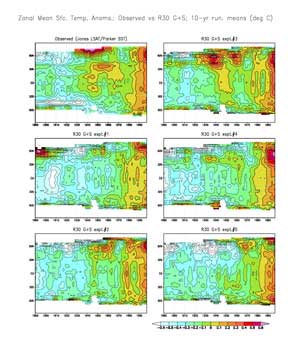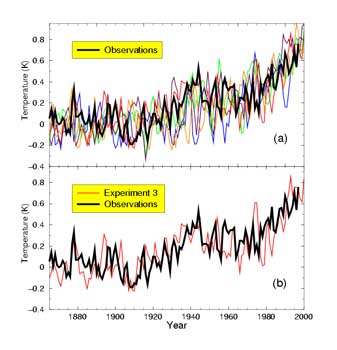Simulation of Early 20th Century Global Warming
The observed global warming of the past century occurred primarily in two distinct 20 year periods, from 1925 to 1944 and from 1978 to the present. While the latter warming is often attributed to a human-induced increase of greenhouse gases, causes of the earlier warming are less clear since this period precedes the time of strongest increases in human-induced greenhouse gas (radiative) forcing. Results from a set of six integrations of a coupled ocean-atmosphere climate model suggest that the warming of the early 20th century could have resulted from a combination of human-induced radiative forcing and an unusually large realization of internal multidecadal variability of the coupled ocean-atmosphere system.
Several climate models accurately simulate the global warming of the late 20th century when the radiative effects of increasing levels of human-induced greenhouse gases (GHG) and sulfate aerosols are taken into account. However, the warming in the early part of the century has not been well simulated using these two climate forcings alone. Factors which could contribute to the early 20th century warming include increasing greenhouse gas concentrations, changing solar and volcanic activity, and internal variability of the coupled ocean-atmosphere system. The relative importance of each of these factors is not well known.
In this study we examine results from a set of five integrations of a coupled ocean-atmosphere model forced with estimates of the time-varying concentrations of GHG and sulfate aerosols over the period 1865 to the present. The coupled ocean-atmosphere model used, developed at the Geophysical Fluid Dynamics Laboratory, has a spacing of roughly 300 km between model grid points. The radiative perturbations for the five integrations are identical. The experiments differ only in their initial conditions, which were selected from widely separated times in a long control integration that had no radiative perturbations.
Figure 1. (a) Time series of global mean surface temperature from the observations (heavy, black line) and the five model experiments (various colored lines). Units are K expressed as deviations from the period 1880-1920. (b) Same as (a), except that only one of the model experiments is shown. (Click on image to view larger version.)
Time series of annual mean, global mean surface temperature from the five GHG plus sulfate integrations (Figure 1, upper panel) show an increase over the last century which is broadly consistent with the observations. The individual runs – denoted as Experiments 1 through 5 – form a spread around the observations, indicating the internal variability inherent in the model.
One of the integrations (Experiment 3, reproduced in the lower panel of Figure 1) shows a remarkable similarity to the observed record, including the amplitude and timing of the warming in the early twentieth century. Since the model includes no forcing from interdecadal variations of volcanic emissions or solar irradiance, this suggests that the observed early 20th century warming could have resulted from a combination of human-induced increases of atmospheric GHG and sulfate aerosols, along with internal variability of the ocean-atmosphere system.
In terms of regional structure (Figure 2), the observed early 20th century warming shows a pronounced maximum at higher latitudes of the Northern Hemisphere (Figure 2, top left). A similar warming at high latitudes of the Northern Hemisphere is also seen in Experiment 3 (Figure 2, top right), thereby lending credibility to the possibility that the model warming arises from physical processes similar to those important for the observed warming. The four other GHG plus sulfate experiments show a range of variability in the early part of the record, illustrating the internal variability of the model. For example, note the pronounced high northern latitude cooling in the 1920s and 1930s that occurs in Experiment 5. A more general warming occurs in all the Experiments and in the observations over the last several decades (orange and red colors toward the right side of each panel), suggesting a robust forced response of the climate during this period to increasing concentrations of greenhouse gases.
 Figure 2. Zonal mean anomalies of surface temperature for the observations (upper left panel) and the five model experiments. Units are K. Values are 10-year means plotted at the ending year of the 10-year period. For the model output, only times and locations for which there were observational data were used in the calculations. (Click on image to view larger version.)
Figure 2. Zonal mean anomalies of surface temperature for the observations (upper left panel) and the five model experiments. Units are K. Values are 10-year means plotted at the ending year of the 10-year period. For the model output, only times and locations for which there were observational data were used in the calculations. (Click on image to view larger version.)The conclusions in this study are dependent on the model’s climate sensitivity, internal variability, and the specification of the time-varying human-induced radiative forcing. For example, if the climate sensitivity were smaller, then one would need either larger internal variability or additional radiative forcings to capture the early 20th century warming. The climate sensitivity of this model is approximately 3.4K, which is in the upper half of the 1.5K-4.5K range cited by IPCC.
Assuming the simulated variability and model response to radiative forcing
are realistic, the results of the present study demonstrate that the combination of greenhouse gas forcing, sulfate aerosols, and internal variability could have produced the early 20th century warming, although to do so would take an unusually large realization of internal variability. A more likely scenario for interpretation of the observed warming of the early 20th century might be a smaller (and therefore more likely) realization of internal variability coupled with additional external radiative forcings.
Additional experiments with solar and volcanic forcing, as well as with improved estimates of the direct and indirect effects of sulfate aerosols, will help to further constrain the causes of the early 20th century warming. The results of the present study clearly demonstrate the fundamental need to perform ensembles of climate simulations in order to better delineate the uncertainties of climate change simulations associated with internal variability of the coupled ocean-atmosphere system.
Further details regarding this study were published by T. Delworth and T. Knutson of NOAA/GFDL in the 24 March 2000 issue of Science (vol. 287, pp. 2246-2250).
Overviews of other GFDL climate research topics can be found on our NOAA /GFDL home page.



